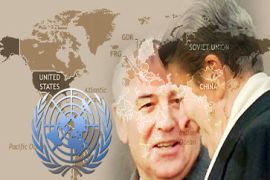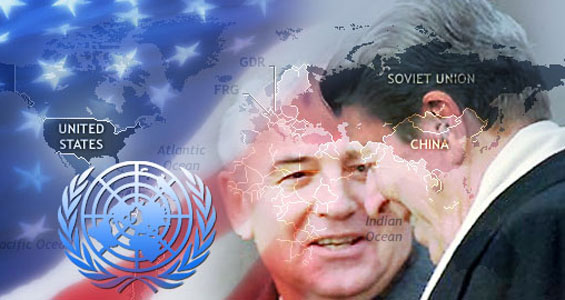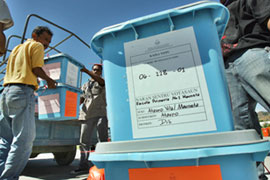Cold War’s shadow on UN operations
Peacekeeping operations were scuttled by the clash of Soviet and US foreign policy.

 |
| The end of the Cold War allowed increased consensus on peacekeeping missions [AlMishaal] |
During the first 45 years of its existence, the UN thrived despite the often bitter clash between Cold War rivals, the US and the Soviet Union.
However, once the Berlin wall came down, the fundamental changes in international politics directly impacted the balance of power in the UN and its operations around the world.
Keep reading
list of 4 itemsWhat happens when activists are branded ‘terrorists’ in the Philippines?
Are settler politics running unchecked in Israel?
Post-1948 order ‘at risk of decimation’ amid war in Gaza, Ukraine: Amnesty
The end of the Iron Curtain allowed the UN to significantly develop its practices and operations, as well as change attitudes towards issues on the international agenda.
Members of the international community began to view world crises through a different prism, particularly in the way the UN assumed broad mandates in conflict interventions in a number of regions.
The UN now has 16 specialised agencies and numerous other bodies and institutions dealing with public affairs on a global level.
These bodies have allowed the UN to influence national policies and to intervene in many areas that would have been clearly unreachable during the Cold War and would have been considered intrusive intervention in domestic affairs of member states.
Peace-building impeded
It is generally agreed among post-conflict reconstruction experts that the end of the Cold War was an important precondition for the surge of peace-building operations in the early 1990s.
Collective security during the Cold War was limited to peacekeeping and preventive diplomacy.
According to Chapter VI of the Charter, whenever a dispute arises, the Security Council must first seek to bring about a peaceful settlement.
If the parties of a dispute fail to settle by non-violent means of their own choice, the Security Council must call upon them to settle it. The Council may then investigate any dispute or situation to determine whether it is likely to endanger international peace and security.
The Security Council may decide on necessary action when it determines that a threat to peace exists or that an act of aggression has occurred.
Increased peacekeeping
 |
| UN peacekeepers patrol Kiwanji, Congo [AFP] |
The UN Charter envisages the application of graduated measures, from economic and diplomatic sanctions to military action according to Chapter VII, which calls on all member states to assist the council in this endeavour.
However, during the Cold War, no agreements were concluded that would give this measure effect except in 1953 and 1990, authorising the Korean War and the Gulf War to oust Iraq from Kuwait, respectively.
The disparity in points of view over global security between the Americans and the Soviets also meant that few peacekeeping operations were undertaken.
During the Cold War, actions to maintain international peace and security often took the form of peacekeeping missions.
In such missions, UN troops were placed in areas of conflict to defuse tensions and were deployed only in situations in which all parties to the conflict in question agreed to their emplacement.
UN troops were absent in the conflicts in Cambodia, Vietnam, Afghanistan, Cuba, Falklands, El Salvador and Panama because these conflicts involved one or more of the permanent Security Council members who had the power to veto any resolution calling for their deployment.
During the Cold War, the ‘Great Powers’ were satisfied with judging UN activities based on the balance of power.
Peacekeeping missions have generally been used after a stalemate in fighting has been reached or after allied states (such as the United States and the Soviet Union) have agreed to place joint pressure on those in the conflict to reach a ceasefire.
As a result, UN peacekeeping has most often been used to contain existing conflicts rather than to prevent the outbreak of new wars.
Breaching the divide
However, with the end of the Cold War, social democratic principles came to be viewed as the cornerstones for development and stability and the feasibility of creating a permanent UN ‘standby’ force for urgent deployment was again raised.
As a result, not since 1945 has the UN enjoyed such support across the East-West divide, as it has since 1989.
Appeals to the UN for peace-making purposes increased dramatically, renewing discussions about the likelihood of putting into practice the original UN provisions for collective security.
These forces were to remain neutral and use force only for self-defence purposes.
The new apparent rapport between former Cold War adversaries created a sense of optimism over the role of the UN in providing a more peaceful world.
In 2003, Edward Mortimer, the director of communications in the office of the UN secretary-general, said: “During the Cold War, the United Nations was quite used to being denounced as a useless or unimportant talking-shop.”
However, he argued that with the end of the Cold War there appeared to be a chance that the organisation could actually be what its founders intended it to be; an impression of sudden universal support for international conflict management.
Supervising elections
 |
| The UN monitored elections in East Timor [AFP] |
Since 1990, the UN has supervised elections in many parts of the world, encouraged peace negotiations, and has distributed aid and assistance in others.
UN troop presence during the violent and protracted disintegration of Yugoslavia and its mission in East Timor and more recently the engagement of the UN in Afghanistan renewed discussions about the role of the UN in assisting peace and stability.
In the short period from 1988 to 1993, there was substantially more UN military operations than during the organisation’s first 40 years. These operations are characterised by three principal elements.
The first element is the nature of international politics after the end of the Cold War that defines collective response to emergent crises.
The second element is the nature of the conflict in which the international community intervenes. The third element is the goals that the intervener sets forth, thus determining the type of intervention it undertakes.
Defining peace operations
In past years there has been much debate on defining UN peace operations and the more complex operations in the post-Cold War era.
The phrases ‘nation-building’, ‘peace-building’, and ‘state-building’ are all used to define recent UN operations such as those seen in East Timor, Kosovo and Afghanistan.
These terms need to be carefully defined and their relationships to each other must be understood.
The US, UN officials, and notable scholars are usually the ones that define these terms and apply them as they find suitable. State-building has only recently been considered vital to establishing peace by state institutions; peace-building as opposed to state-building is probably a more inclusive term.
Nevertheless, the use of the term state-building seems to come as a response to use of the term nation-building by the US Republican administration, particularly in Afghanistan and Iraq.
Lakhdar Brahimi, a former special advisor to the UN secretary-general, argued in 2007 that “the concept of nation-building, often used in reference to development efforts in post-conflict states is misleading”.
Brahimi suggested that the use of the term nation-building “reflects the specifically American experience of constructing a new order in a land of new settlement without deeply rooted peoples, cultures and traditions”.
State-building
 |
| Nation-building involves creating viable food resource infrastructure [REUTERS] |
In fact nations cannot be built by foreigners descending on a country for a short period of time. Nations emerge through complex long-term processes based on common elements and history.
In defending the use of the terms ‘nation building’, the Rand corporation, a US-based think tank, defined state-building, as a process of reform and strengthening governmental institutions.
It said these “do not normally or necessarily require the application of military forces … Nation-building, by contrast, has become almost universally identified with state-building missions that require the use of such force”.
These two very different arguments reflect the dispute over the nature of state-building processes in a post-conflict context. This justification does not sound convincing since nation-building is a term of enormous scope.
It includes the various processes involved in organising people into strong and prosperous communities living within the borders of a state. Nation-building is primarily a political/ideological function and the question of national identity is at the heart of it.
State-building, on the other hand, is a technical function concerned with the construction of the social, economic, political and institutional infrastructure of a stable society. It is the creation of a viable administrative and political apparatus, the institution of government and a self-sustaining economic framework.
Strengthening government institutions
Until recently, the term peace-building was generally preferred within the UN.
Boutros Boutros Ghali, the former UN secretary-general, wrote in his 1992 treatise An Agenda for Peace, “reforming or strengthening governmental institutions” is key to peace-building.
By 1995, in his supplement, Ghali said the essential goal is to ensure “the creation of structures for the institutionalisation of peace”.
That would contribute directly or indirectly to the re-establishment of functioning state-hood. Since the end of the Cold War, “the United Nations increasingly finds itself in operations that seek to build or re-build the institutions of a state”.
Since the early 1990s there have been a number of nations that have gained their independence as a result of the liquidation of the Soviet Union and most recently, other cases such as East Timor and Kosovo.
The UN increasingly finds itself in operations that seek to build or re-build the institutions of a state.
This led Brahimi in 2007 to argue that “the term peace-building does not encompass fully the tasks that must be carried out in order to reconstitute a viable and functioning state”.
He added: “In post-conflict situations, there is an absence of war, but not necessarily real peace.
“The end of fighting does offer an opportunity to work towards lasting peace, but that requires the establishment of viable institutions, capable of ensuring lasting security for the entire population.”
One could argue that the use of the term state-building is more appropriate in regards to the process of building functioning state institutions to ultimately achieve peace.